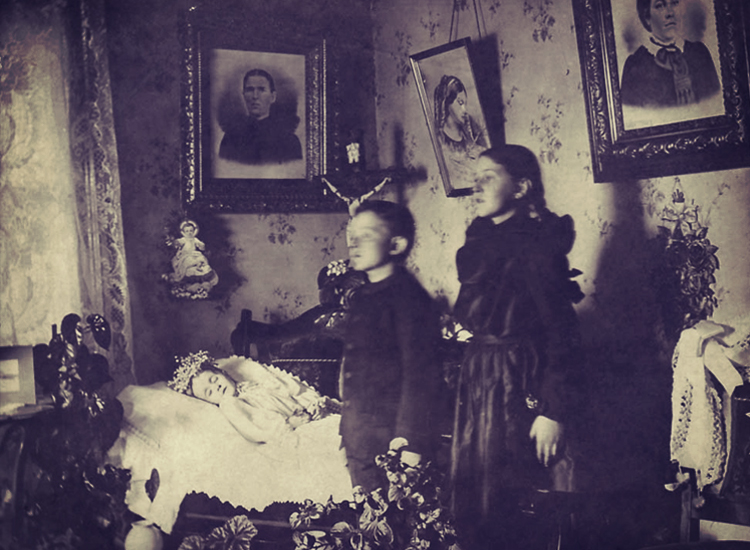
Image: Diaries, Ghost, et al. “Memento Mori: The Macabre Victorian Art of Death Photography.” The Occult Museum, 16 May 2017, https://www.theoccultmuseum.com/memento-mori-macabre-victorian-art-death...
Overview
Memento mori, the ancient philosophy of reflecting on death, was represented in Victorian funerary practices through limiting social activity, donning customary mourning clothes, hosting lavish funerals, and memorialising the deceased through art. Memento mori art used a range of methods to preserve their loved ones memories: symbolic carvings and inscriptions on tombstones; death masks; memoriam trinkets such as keepsake locks of hair, bone fragments, pendants, clocks and stopwatches; literary texts with the dead as the subject; and macabre illustrations and post-mortem photography. All memento mori practices and artefacts became synonymous with death during the Victorian period (Lutz 2-5).
Historical
Britain’s long-standing fascination with death reached beyond the 19th Century and took root during the middle ages when the Latin text Ars moriendi, the art of dying, detailed the protocols of a “good death” and how to “die well” (Victorians and the art of dying). Believing established funeral practices were essential to the progression and judgement of the soul, Britain developed an obsession with the fate of souls after death. As a result, Victorians sought to capture pieces of their loved ones through elaborate funerary practices and memento mori keepsakes. Families would often gather at the bedside of their deceased and dying to remove or create memento mori which they would carry with them throughout their lives. This funerary practice allowed for a constant reminder of their dead.
Significance in Victorian Litearture
Victorian literary authors were no exception to exploring themes of death and the purpose of souls. In Charlotte Brontë’s Jane Eyre, multiple instances of death are discussed, and one significant death depicted is that of Helen. Jane exercises the common Victorian custom of gathering with the dying and visits Helen upon her deathbed. Helen remarks to Jane that she (Jane) “came to bid her good-bye” before she goes to her “last home” (Eyre 96). While discussing the nature of souls and life and death, Jane, intent on keeping Helen close to her, interlinks her arms with Helen. Though Jane doesn’t create a physical keepsake, Jane’s intentional experience with Helen does create a memory with the deceased that can be viewed as a symbolic act of memento mori. (Eyre 97). Another instance of memento mori in Jane Eyre is the matter of remembering the departed, is found in Jane’s marking of Helen’s grave with the tombstone bearing the inscription Resurgam, I shall rise again (Brontë ). Helen’s final moments spent with Jane and the act of Jane honouring her dear friend through marking her resting place, are engraved not only in her memory and the land, but also in Jane's biography– forever memorialising her dear friend.
In Victorian novelist Wilkie Collins’s The Woman in White, death and decline serve as an overarching theme. Numerous deaths of central characters occur throughout the novel, and pointed descriptions of decay add to the atmosphere of demise. Collins includes a particularly brief passage that details mourning customs that most Victorians abided by. While meeting with Walter Hartright, Mrs. Catherick learns of Anne's death. In a "stony" manner, Mrs. Catherick replaces her slate-coloured gloves with the Victorian expected and appropriate black mourning mittens (Collins 485).
Understanding Victorian funerary customs and memento mori has the capability to enrichen our experience while exploring the Victorian world. Whether through passages of tender friendship such as the passing of Helen in Jane Eyre or the calculating mother, Mrs. Catherick, in The Woman in White, memento mori allows us connections to humanity, both the heartwarming and the cold.

[[File:Brooch containing human hair, Europe, 1701-1900 Wellcome L0058632.jpg|Brooch_containing_human_hair,_Europe,_1701-1900_Wellcome_L0058632]]
Works Cited
Brontë, Charlotte. Jane Eyre. Signature Classics, 2022.
Collins, Wilkie. The Woman in White. Penguin Books, 2020.
Lutz, Deborah. Relics of Death in Victorian Literature and Culture. Cambridge University Press, 2017.
“Victorians and the Art of Dying.” Sky HISTORY TV Channel, https://www.history.co.uk/history-of-death/victorians-and-the-art-of-dyi...
